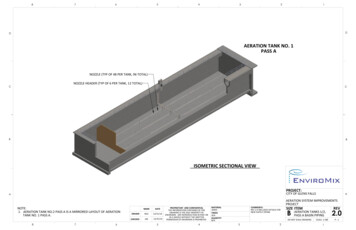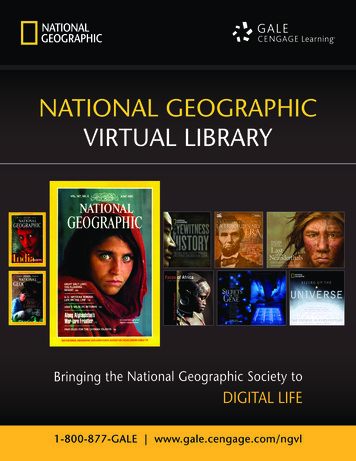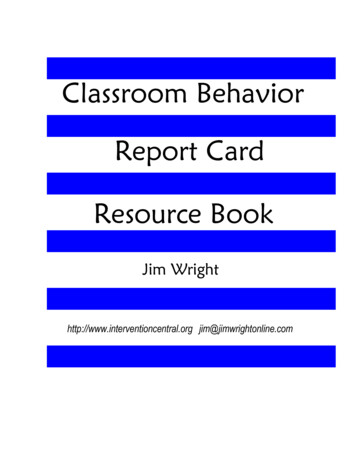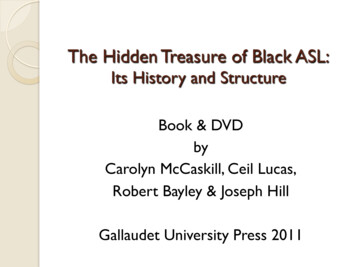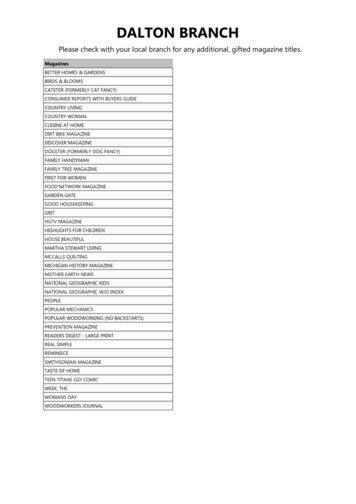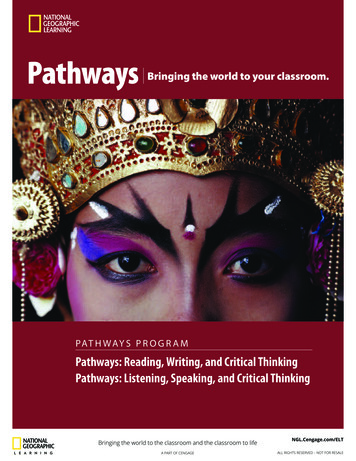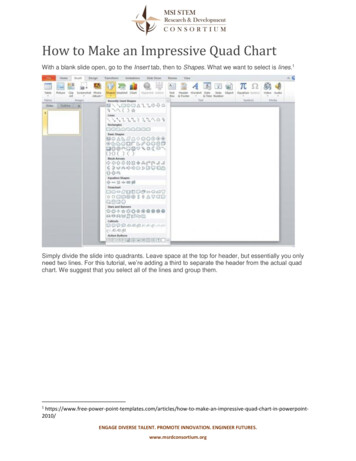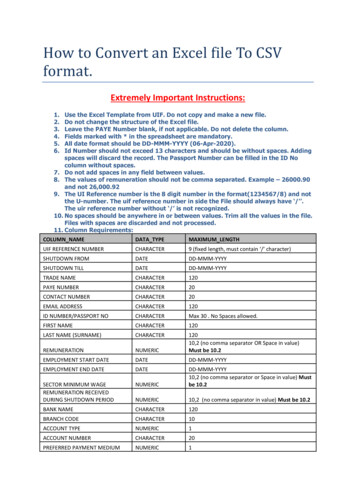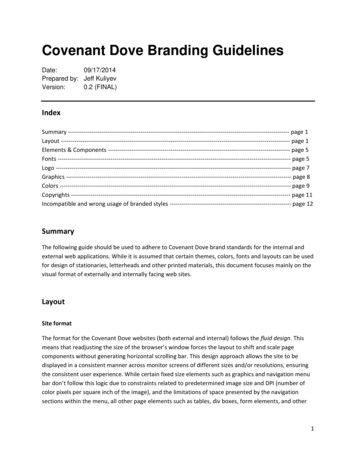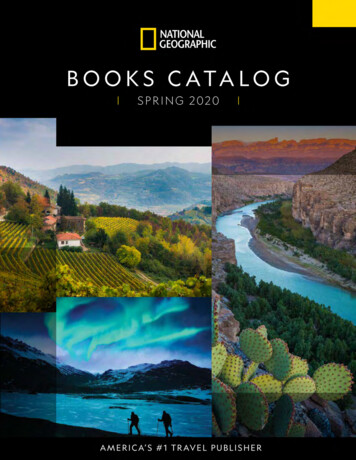
Transcription
HEADER TKDEAR READERS,This spring, we’re delighted to present an exciting collection of books that will inspire you to embark onnew adventures, both at home and abroad. We begin with a spellbinding new memoir from legendaryexplorer Bob Ballard. Filled with the inside stories of his most celebrated exploits, including his discoveryof the Titanic 35 years ago, Bob Ballard (final title to come) is a thrilling tale that combines cutting-edgescience, archaeology, oceanography, and secret military missions. Talk about the perfect beach read!Next, pack your bags, lace up your hiking boots, and get ready to be inspired by a bevy of travel booksthat will help you explore our world. In Always Italy, best-selling author Frances Mayes (Under the TuscanSun) celebrates the best of “The Boot” in her lyrical insider’s guide to the country’s 20 regions. In thedazzling Complete National Parks of Europe, you’ll explore the natural wonders of the Continent,featuring 460 sites from the United Kingdom’s Exmoor to Croatia’s Kornati Island. Commune with naturein 100 Hikes of a Lifetime, a collection of the most breathtaking trails around the world for wanderers ofall skill levels. Or if driving is more your style, cruise through 100 Drives, 5,000 Ideas, a collection ofdiverting road trips across the United States and Canada that includes historic routes, foodiedestinations, national parks, and more.Best of all, the adventure continues here at home. In the highly anticipated follow-up to their groundbreaking narrative What to Eat When, best-selling authors Dr. Michael Roizen and Dr. Michael Crupainare back with The What to Eat When Cookbook. Filled with 125 delectable recipes and more than 100mouthwatering photos, this inspiring program will help you achieve your most important life goals, fromprofessional success to weight loss to longevity. Stay on a roll with blog maven Kris Bordessa’s AttainableSustainable, written for DIY-lovers seeking earth-friendly, self-sufficient lifestyles. This indispensablelifestyle reference is packed with natural remedies, delicious recipes, gardening tips, crafts, and morethan 300 four-color photos.Finally, take a walk on the wild side with the wacky, informative, and downright gruesome Gory Details.Written with wit and style by Erika Engelhaupt, founding editor of the popular eponymous blog, thiscaptivating narrative is filled with far-out facts about the astonishing world of science, from thebiologist who stung himself with every conceivable insect to dollhouse-size replicas of crime scenesbuilt to analyze blood splatter.As always, thank you for supporting National Geographic—our books and our mission.Warmly,LISA THOMASPublisher and Editorial DirectorNational Geographic Books
CONTENTSIDECEMBER 2019The Psychobiotic RevolutionWhat to Eat WhenF E B R UA RY 2 0 2 0National Geographic Complete NationalParks of Europe100 Hikes of a LifetimeNational Geographic Traveler: Italy,Sixth EditionNational Geographic Traveler: Japan,Sixth EditionNational Geographic Traveler: Rome,Fifth EditionNational Geographic Traveler: Scotland,Third EditionNational Geographic Walking Guide:London, Third EditionNational Geographic Walking Guide:Paris, Third EditionWhen Women Ruled the WorldIn Praise of Difficult WomenM A RC H 2 02 0Frances Mayes Always ItalyAttainable Sustainable100 Drives, 5,000 IdeasThe Blue Zones of HappinessAPRIL 2020The What to Eat When CookbookM AY 2 0 2 0Bob Ballard (final title to come)Gory DetailsThe Allies2IB Y P U B L I C AT I O N DAT EN AT I O N A L G E O G R A P H I C S P R I N G 2 0 2 0161611121414141415151717481018631318B Y C AT E G O RYH E A LT HThe What to Eat When CookbookThe Psychobiotic RevolutionWhat to Eat WhenThe Blue Zones of Happiness6161618H I S TO RYBob Ballard (final title to come)In Praise of Difficult WomenWhen Women Ruled the WorldThe Allies3171718N AT U R EAttainable SustainableSCIENCEGory DetailsT R AV E LFrances Mayes Always Italy100 Drives, 5,000 IdeasNational Geographic Complete NationalParks of Europe100 Hikes of a LifetimeT R AV E L G U I D E SNational Geographic Traveler: Italy,Sixth EditionNational Geographic Traveler: Japan,Sixth EditionNational Geographic Traveler: Rome,Fifth EditionNational Geographic Traveler: Scotland,Third EditionNational Geographic Walking Guide:London, Third EditionNational Geographic Walking Guide:Paris, Third Edition8134101112141414141515
H I S TO RYBOB BALLARD( F I N A L T I T L E TO C O M E )A N E X P LO R E R’ S L I F ERobert D. Ballard, discoverer of Titanic, with Christopher DrewC OV E RTOCOMEThe legendary explorer of Titanic and Lusitania looks back on his life and unveils amajor new discovery on the 35th anniversary of the Titanic find.Best known for finding the wreck of the Titanic, celebrated adventurer Robert Ballard hasa lifetime of stories about exploring the ocean depths. From discovering extremophilelife-forms thriving at 750 F in hydrothermal vents to finding famous shipwrecks includingthe Bismarck and PT 109, Ballard has made history. Currently the captain of E/V Nautilus, astate-of-the-art scientific exploration vessel rigged for research in oceanography, geology,biology, and archaeology, he leads young scientists as they map the ocean floor, collectartifacts from ancient shipwrecks, and relay live-time adventures from remote-controlledsubmersibles to reveal amazing sea life. Now, for the first time, Robert Ballard gets personal,telling the inside stories of his adventures and challenges as a midwestern kid with dyslexiawho became an internationally renowned ocean explorer. Here is the definitive story of thedanger and discovery, conflict and triumph that make up his remarkable life.ROBERT D. BALLARD has conducted more than 150 deep-sea expeditions and is a pioneer in thedevelopment of advanced deep submergence and telepresence technology. He is best known fordiscovering hydrothermal vents, the sunken R.M.S. Titanic, the German battleship Bismarck, and manyother ancient and modern shipwrecks around the world. Since 2008 he has managed the E/V Nautilus,his flagship for exploration, operated by the Ocean Exploration Trust and funded in part by NOAA.Among his many honors he holds the Explorers Club Medal, the National Geographic Hubbard Medal,and the National Endowment for the Humanities Medal.CHRISTOPHER DREW is an award-winning New York Times investigative journalist and co-author ofBlind Man’s Bluff, a major New York Times bestseller.US ON SALE DATE: MAY 12, 2020978-1-4262-2099-9 HCUS 30.00/CAN 40.006 9 INCHES336 PAGES50 PHOTOGRAPHS100,000 WORDSRIGHTS: WDUK ON SALE DATE: JUN 11, 2020978-1-4262-2099-9 HCUK 20.00152 229 MMALSO AVAILABLE IN EBOOKIA L S O AVA I L A B L ENo Dream Is Too HighUS on Sale: 20165-1/2 8-1/4 Inches140 210 mm224 Pages, 23 Illustrations60,000 Words978-1-4262-1649-7 HCUS 22.00/CAN 29.00978-1-4262-1914-6 PBUS 14.00/CAN 19.00RIGHTS: WD, AUDSFRS: BRAOn AssignmentWith National GeographicUS on Sale: 20135 7 Inches127 178 mm136 Pages, 200 Illustrations25,000 Words978-1-4262-1013-6 PBUS 9.95/CAN 11.95RIGHTS: WDFRS: CHI, DEN, FIN, GER, ITA, NOR, SWEALSO AVAILABLE IN EBOOKN AT I O N A L G E O G R A P H I C S P R I N G 2 0 2 03
T R AV E LF R A N C E S M AY E S A LWAY S I TA LYFrances Mayes, with Ondine CohaneIn this lavishly illustrated and gift-worthy guide, the world’s most beloved expert onla dolce vita takes readers on the ultimate insider’s tour of Italy’s 20 iconic regions, revealinglittle-known gems, off-the-beaten-path destinations, and one-of-a-kind experiences.This lush guide, featuring more than 350 glorious photographs from National Geographic,showcases the best Italy has to offer from the perspective of two women who have spenttheir lives reveling in its unique joys. In these illuminating pages, Frances Mayes, the authorof Under the Tuscan Sun and many other bestsellers, and New York Times travel writerOndine Cohane reveal an Italy that only the locals know, filled with top destinations andunforgettable travel experiences in every region. From the colorful coastline of CinqueTerre and the quiet ports of the Aeolian Islands to the Renaissance architecture of Florenceand the best pizza in Rome, every section features insider secrets and off-the-beaten-pathrecommendations—for example, a little restaurant in Piedmont known for its tajarin, a pastamade from 30 egg yolks that is the perfect bed for the region’s celebrated truffles. Here arethe best places to stay, eat, and tour, paired with the rich history of each city, hillside town,and unique terrain. Along the way, you’ll make stops at the country’s hidden gems—artgalleries, local restaurants, little-known hiking trails, spas, and premier spots for R&R.Inspiring and utterly unique, this vivid treasury is a must-have for anyone who wants toexperience the best of Italy.FRANCES MAYES is the author of four bestsellers, Under the Tuscan Sun, Bella Tuscany, Everyday inTuscany, and In Tuscany. All are about taking chances, living in Italy, and the “voluptuousness of Italian life.”A widely published poet and essayist, Mayes has written numerous memoirs, books of poetry, and novels.Formerly a professor of creative writing at San Francisco State University, she now devotes herself full-timeto writing, traveling, and restoring a historic garden. She and her husband divide their time betweenNorth Carolina and Cortona, Italy.ONDINE COHANE, a contributing editor at Condé Nast Traveler, writes regularly for the New York Timestravel section, among many other publications. She has appeared on CNN and Good Morning America,and co-hosts Condé Nast Traveler’s Insider Guide series on PBS. Cohane lives in the Renaissance town ofPienza in southern Tuscany and owns two boutique hotels.US ON SALE DATE: MAR 31, 2020978-1-4262-2091-3 HCUS 35.00/CAN 47.007-1/8 9-1/8 INCHESI416 PAGES375 PHOTOGRAPHS, 1 MAP110,000 WORDSRIGHTS: WDA L S O AVA I L A B L ENational Geographic Traveler:Italy, Sixth EditionUS on Sale: 20205 8 Inches127 203 mm400 Pages150 Photographs, 29 Maps107,000 Words978-8-8544-1583-6 PBUS 21.99/CAN 28.99RIGHTS: WDFRS: ARG, BUL, CZE, FRA, GER,NET, POL4N AT I O N A L G E O G R A P H I C S P R I N G 2 0 2 0Tasting ItalyUS on Sale: 20189-1/8 10-7/8 Inches232 276 mm384 Pages360 Photographs, 45 Maps110,000 Words978-1-4262-1974-0 HCUS 40.00/CAN 50.00RIGHTS: WDFRS: BUL, TAIUK ON SALE DATE: APR 30, 2020978-1-4262-2091-3 HCUK 25.00181 232 MM
T R AV E LChapter ThreeLOMBARDYThe northern Italian lakes! The air turns blue at evening, sending blessed calm overthose gathered on a terrace for sunset toasts. By day, the mountains change colorsas clouds wander over blissful waters, emerald and indigo. Start with one of theprettiest villages on Lake Como, Bellagio. Gardens, cruises, and peaceful walks provide doses of beauty, while the Rockefeller Foundation’s Bellagio Center, a privateretreat for gifted researchers and writers, lends intellectuallemons, bananas, and tumbling plumbago. Sheltering moun-gravitas to the quaint town. That lady in the big hat sittingtain ranges ensure a Mediterranean climate, with snow-near you at the café may be translating gnostic gospels. Cer-topped peaks in the near distance. How fun to round a bendnobbio, close to the town of Como, is known for silk fabrics,and come upon bevies of windsurfers, their colorful crescentand many honeymooners seek the romantic hotel Villa d’Este.sails skimming in rhythmic motions across the silvery waters.This 16th-century palace is sure to start a marriage off withhigh expectations.Traffic and parking aren’t fun, but once you are ensconcedin a dreamy lake hotel, simply forget the sprawl just behindOn Lake Garda, largest of the northern lakes, I chose well:you. What I recommend: Find the prettiest spot on the lakethe Grand Hotel Fasano. This elite watering hole of the 19thand give yourself over to luxury. Check into the stupendouscentury vibrates with privilege. The lobby exudes light-heartedVilla Feltrinelli if you’ve come into a recent inheritance. (Spendelegance, all cream and gold, accessorized with caged, singingAunt Hazel’s legacy. It’s worth it.) Otherwise, Villa Fiordalisobirds. Their excellent restaurant, Il Fagiano, revels in rich pan-or Grand Hotel Fasano will suffice quite nicely. Of course,eling, ritual flambéing in copper, and friendly formality.every village has a range of accommodations.Lake Garda is the spot to pamper your stressed-out self.The lake towns all face colorful harbors, have a lungolagoArrange a private boat to arrive at your hotel dock and whiskyou around to Salò, Desenzano del Garda, Gardone Riviera,Sirmione, Limone del Garda, and Riva del Garda, the loveliesttowns on the lake. Between the towns of Desenzano, at thesouth end of the lake, and Riva del Garda at the top, publicboats run all year. You can hop off at all 16 pretty lake towns.But it’s more relaxing to hire a captain to take you where youwant, wait while you have lunch, or enjoy drinks on board.Plying the lake by boat is optimal; otherwise, you must driveWHAT YOU NEED TO KNOW BEST TIME TO VISIT : Unlike some Italian cities whichessentially close in summer, Milan stays open yearround following business travelers as opposed to just theleisure visitors. And with Alpine sports a close driveaway in winter, it can be nice to combine the trip with ajaunt up into the mountains (or in spring, summer, andfall, the lake region). The fog here is legendary, so don’tbe surprised if you experience flight delays.to the lakefront towns. Studded with cypresses, the road takes TOP SPOTS : Milan, Lake Como, Mantuayou to villages festooned with oleander, bougainvillea, palms, GETTING THERE: Linate and Malpensa Airports, both in MilanIl Vittoriale degli Italiani is a complex of buildings, streets, and gardens built in the early 20th century and once home to Gabriele D’Annunzio.46Always ItalyPiedmont47opBest OfOutdoor Activities in PiedmontWhile most people head to Piedmont to eatand drink, the region is also a hidden get-tected vineyards of the Langhe Valley to the former palacesof Savoia is a true delight.away for outdoor pursuits (mountain biking,skiing, and hiking) as well. JayWay Travel offers tours allSail the Lakes: Rent a boat or follow the shores of Lakeover the country, but Piedmont native Daniele TonioloMaggiore by foot. Way less crowded and expensive thanknows his home territory particularly well. You can chooseComo, it also boasts treasures like the town of Orta Santo stay active throughout your stay or combine those activi-Giulio with its exquisite Piazza Mario Motta. From there,ties with one of its custom itineraries from vineyard visits tocity tours. Here are some of the pursuits to keep youryou can get on a little boat to the lake’s main island, IsolaSan Giulio.adrenaline going.Climb Every Mountain: To get a real sense of theSki With the Pros: Turin was the site for the WinterOlympics in 2006, and its lifts, trails, and level of instructors still shine from the spotlight. La Val di Susa is one ofgeography of the region, try an Alpine trek: a day trip toMonviso, a multiday journey to Gran Paradiso, or an expedition from Piedmont all the way into Switzerland.the epicenters for the activity. Nicknamed “the MilkyWay,” the varied terrain offers runs for all levels, as well asTake Flight: Paragliding is quite popular on the gentle15 ski schools. In addition to Piedmont’s own ski areas, youhills that form the landscape before the Alps, and seeing thecan use an international ski pass to venture into FranceBarolo vineyards from a hot air balloon another option forand Switzerland. In the summer, these same spots becomethose who don’t have a fear of heights.fantastic hikes and spots for rock climbing or mountainbiking destinations.Ride the Wind: Motorbike and vintage Vespa enthusiasts often hit the region on wheels. Electric bikes areFollow the Royals: Hiking through the UNESCO-pro-another popular option.opposite: The town of San Giulio on Lake Orta above: Mountains above the Gardone RivieraGet lost in the mountains or in some of thecountry’s most suggestive cities. From fashion towine, northern Italy has the stars.Welcome to Italy’s richest area—inluxury mixed in with the pristine scenery. And for soccerboth economic output and geo-fans, this is the land of some of Italy’s most famous teams—graphical diversity. Mountains drawnot to mention sleek automobiles (think Fiat, Lamborghini,outdoorsy types. Cities like Milanand Ferrari).pull in bankers and fashionistas, andHere too a veritable treasure trove of some of the coun-Venice offers some of the most beautiful tableaus in Italy. Intry’s most famous wines. DOC, a denomination to protectthe far north, the culture remains deeply influenced by otherproducts from specific terroirs, Italian ingredients like pro-cultures, like those of Austria and Slovenia.sciutto, truffles, Parmesan, chocolate, coffee, and balsamicCome spring, temperatures tend to be cooler, thevinegar all speak to the north’s fertility.shoulder season (September to November) is great forIt’s no wonder that with all of these riches—literal andeating and drinking, and winter and summer are fine forfigurative—the North also has a reputation for being a bitthose who enjoy nature. Spa culture also abounds forsnobby. This is especially true in its attitude toward itswellness seekers.southernmost cousins, who are often largely blamed for theThe rest of the region beckons with equally appealingeconomic problems of the country. Southerners, on thepursuits. Smaller towns like Mantua and Udine remain daz-other hand, feel that northerners are cold. There is somezling without too many tourists, while the coastline of Liguriatruth to this stereotype: You are unlikely to get as warm aand the Italian Riviera still shine despite legions of fans.welcome in Milan, for example, as you would in Naples orCerulean lakes that have attracted visitors for centuries arePalermo. But who cares? You will be too busy choosing howreinventing themselves for 21st-century travelers who liketo enjoy its treasures.clockwise from top left: Quintessential gondolas on Venice’s rightly named Grand Canal; a sublime dish at Milan’s tiny 10 Posto restaurant; themajestic San Fruttuoso abbey sits right on the sea on the Ligurian coast; writing up the tasty daily specials at Udine’s L’Alimentare.N AT I O N A L G E O G R A P H I C S P R I N G 2 0 2 05
H E A LT HT H E W H AT TO E AT W H E N C O O K B O O K1 2 5 D E L I C I O U S LY T I M E D R E C I P E SDr. Michael Roizen and Dr. Michael Crupain, with Jim PerkoThis inspiring cookbook and strategic eating plan—the sequel to the wildly popularWhat to Eat When—offers 125 delectable recipes geared to achieving your most importantlife goals, from professional success to losing weight to longevity.In their acclaimed lifestyle guide What to Eat When, Dr. Michael Roizen and Dr. MichaelCrupain revealed when to eat foods for healthier living, disease prevention, betterperformance, and a longer life. The key, they assert, is eating breakfast like a king, lunchlike a prince, and dinner like a pauper. Now, in this mouthwatering sequel, they deliver125 recipes to put these lessons into practice, from a fiber-rich pasta dish loaded with freshtomatoes and a creamy lemon dip and homemade crackers to satisfy your snack cravingsto a salmon burger you’ll love to eat for breakfast (yes, breakfast!) and a healthier, decadentchocolate mousse—a treat that also offers hormone-boosting ingredients before you hitthe gym. Each dish is paired with practical information about the nutrients and benefitsof the ingredients, plus expert cooking tips, what portion size to eat when, and helpfulsubstitutions. Covering breakfast, lunch, dinner, and dessert—and the best times to eat allfour—this highly anticipated sequel to Roizen and Crupain’s best-selling eating guide offersa plethora of meals that will get you through the day, and extend your life by years!DR. MICHAEL ROIZEN is the Chief Wellness Officer at the Cleveland Clinic, Chief Medical Consultant onThe Dr. Oz Show, author of four # 1 New York Times best-selling books, and originator of the popularRealAge.com. He is board certified in anesthesiology and internal medicine. He’s been recognized withan Ellie, an Emmy, and the Paul G. Rogers Award from the National Library of Medicine for Best MedicalCommunicator.DR. MICHAEL CRUPAIN is the Medical Director of The Dr. Oz Show. He is board certified in preventivemedicine, a fellow of the American College of Preventive Medicine, and part-time faculty at the JohnsHopkins Bloomberg School of Public Health. Prior to joining The Dr. Oz Show, he directed food safetytesting at Consumer Reports. He is an Emmy award-winning producer and sat on a USDA advisorycommittee.JIM PERKO is the executive chef for the Cleveland Clinic Wellness Institute and the Center for Integrativeand Lifestyle Medicine. A graduate of The Culinary Institute of America, he has apprenticed for theAmerican Culinary Federation 1976 U.S. Culinary Olympic Team and cooked for scientists on the 1977-78U.S. Antarctic Expedition. Perko is the founder of the national award-winning program Food Is Knowledge.US ON SALE DATE: APR 7, 2020978-1-4262-2103-3 HCUS 30.00/CAN 40.007-1/8 9-1/8 INCHESI320 PAGES125 PHOTOGRAPHS85,000 WORDSRIGHTS: WDA L S O AVA I L A B L EBlue Zones KitchenTHE100 RECIPES TO LIVE TO 100DA N B U E T T N E RP H OTO G R A P H S BY DAV I D M C L A I N6The Blue Zones KitchenUS on Sale: 20198 10 Inches203 254 mm304 Pages200 Photographs40,000 Words978-1-4262-2013-5 HCUS 30.00/CAN 39.00What to Eat WhenUS on Sale: 20196 9 Inches152 229 mm352 Pages15 Black & White Illustrations80,000 Words978-1-4262-2011-1 HCUS 28.00/CAN 30.00RIGHTS: WDNO FOREIGN RIGHTSRIGHTS: WDFRS: KOR, POLALSO AVAILABLE IN EBOOKALSO AVAILABLE IN EBOOKN AT I O N A L G E O G R A P H I C S P R I N G 2 0 2 0UK ON SALE DATE: MAY 14, 2020978-1-4262-2103-3 HCUK 20.00181 232 MM
H E A LT HBBQARCT I C CH A RPREP: 20 minutesCOOK: 15 minutesCalories: 120Sugars: 9gMAKES: 2 ServingsSaturated Fat: 0gCholesterol: 0mgFiber: 4.25mgSERVING: 6 oz. fish, ¼ cup sauceProtein: 4gSodium: 240mgCarbohydrate: 25gA relative of salmon, Arctic char is a type of rainbow trout that is healthy andscores high on the EDF’s eco-rating. One filet has 150 calories and 20 grams ofprotein, plus those healthy omega-3 fats. Pair it with our barbecue sauce—a lowsugar and low-sodium alternative to premade versions—for a tasty dinner (orbreakfast—remember, don’t stereotype your food. Barbecue Sauce1. In a medium saucepan combine oil and garlic. Stir overmedium-low heat until garlic is aromatic, about 1 minute.Add all remaining ingredients and whisk until well blended.Increase the heat to medium and simmer until heatedthrough, 4 to 5 minutes. Remove from the heat and setaside to cool.¼ cup toasted sesame oil3large garlic cloves, minced3-¼ cups ketchup (2g sugarper serving)½ cup low-sodium gluten-freetamari2. Reserve 8 tablespoons of the barbecue sauce for the ArcticChar. Label, date and freeze the remaining sauce up to sixmonths for future use.½ cup white grape juice¼ cup fresh lemon juice¼ cup raisin reduction (see p tk)1and cut the fish crosswise into four equal size pieces, each aboutthree ounces. Season evenly with smoked paprika, salt, pepper.tablespoon freshly groundblack pepper Arctic Char13. Preheat the oven to 350 F. Remove the skin from the Arctic Char4. Place the fish pieces on a small baking sheet, spacing apart.Spoon 2 tablespoons of barbecue sauce evenly over eachpiece. Bake just until the fish pieces are opaque in the center,9 to 10 minutes.12- ounce piece bonelessArctic Char fillet, about½ inch thick½ teaspoon smoked paprika¼ teaspoon kosher salt¼ teaspoon coarsely groundblack pepper2T H E W H AT TO EAT WHEN CO OK B O OKFISH & SEAFOOD3S NAP P E A &STRAW B E R RY SALADPREP: 20 minutesCalories: 120COOK: 2 minutesSugars: 9gMAKES: 4 ServingsSaturated Fat: 0gCholesterol: 0mgFiber: 4.25mgProtein: 4gSERVING: 1 cupSodium: 240mgCarbohydrate: 25gThe combination of snap peas and strawberries may sound strange, but it’s oftensaid what grows together goes together; both ingredients are available in spring.This marriage works because the sweet and tart flavors of the strawberries acts likea vinaigrette for the snap peas.1cup small quartered hulledstrawberries (preferably smalllocal strawberries from thefarmer’s market, like the varietycalled “tristar”, if you canfind them1tablespoon thinly sliced freshmint leaves8ounces sugar snap peas2teaspoons extra-virgin olive oil½ teaspoon freshly groundblack pepper1. Combine the strawberries, mint, and a pinch of salt in a mediumbowl. Crush a few strawberry pieces to extract some of theirjuice. Set aside.2. Bring a large saucepan of water to a boil. Add enough salt tomake salty like the sea.3. Meanwhile, clean the snap peas by pulling the pointy endstowards the inside curve, removing the strings.4. Add the snap peas to the boiling water and cook for 2 minutes.Using a slotted spoon or spider, transfer the snap peas to a colander. Run cold water over the snap peas to cool, then let dry.4. Thinly slice the snap peas on the diagonal. Place them in a smallbowl and season with 1/8 teaspoon salt and 1/8 teaspoon pepper.Add them to the bowl with the strawberries and toss gently toblend. Serve.The When WayImmune Booster Snap peas are an excellent source of Vitamin C—just 3.5 ounces provide 100 percent of yourdaily needs. Likewise, strawberries include Vitamin C, manganese, and heart-healthy antioxidants.4T H E W H AT TO EAT W H EN C O O KBO O K5V E G E TA B L E S & S A L A D SNaturally sweetroasted beetsPickled beet stemsSauteed beet greens16T H E W H AT TO EAT WHEN CO OK B O OKV E G E TA B L E S & S A L A D S17N AT I O N A L G E O G R A P H I C S P R I N G 2 0 2 07
N AT U R EAT TA I N A B L E S U S TA I N A B L ET H E L O S T A RT O F S E L F - R E L I A N T L I V I N GKris BordessaATTAINABLESUSTAINABLEthe lost art of self-reliant livingkris bordessaeat make clean grow farm trekPacked with delicious recipes, natural remedies, gardening tips, crafts, and more, thisindispensable lifestyle reference from the popular blogger behind Attainable Sustainablemakes earth-friendly living fun.Whether you live in a city, suburb, or the country, this essential guide for the backyardhomesteader will help you achieve a homespun life—from starting your own garden andpickling the food you grow to pressing wildflowers, baking sourdough loaves, quilting,raising chickens, and creating your own natural cleaning supplies. In these richly illustratedpages, sustainability guru Kris Bordessa offers DIY-lovers an indispensable home referencefor sustainability in the 21st century, with tried-and-true advice, 50 enticing recipes,and step-by-step directions for creating easy, cost-efficient projects that will bring outyour inner pioneer. Filled with more than 300 four-color photographs, this relatable,comprehensive book contains time-honored wisdom and modern know-how for gettingback to basics in a beautiful, accessible package.KRIS BORDESSA’s passion project is the hit blog Attainable Sustainable, which she launched in 2011 tocreate a community focused on self-reliant living. The site asks the question: What if we could tackle onelittle actionable step each day to achieve a more self-reliant lifestyle? Bordessa grew up on a small farmin Northern California where her family harvested apples, raised chickens and pigs, planted acres oftomatoes, and had a Christmas tree farm. These days, she lives in Hawai’i with her husband, two sons, anabundant vegetable garden, and a thriving chicken flock.US ON SALE DATE: MAR 24, 2020978-1-4262-2054-8 HCUS 35.00/CAN 47.007-5/8 9-3/4 INCHESI320 PAGES350 PHOTOGRAPHS100,000 WORDSRIGHTS: WDUK ON SALE DATE: APR 30, 2020978-1-4262-2054-8 HCUK 25.00194 248 MMA L S O AVA I L A B L ENational GeographicAlmanac 2020US on Sale: 20197-1/8 9-1/8 Inches181 232 mm400 Pages700 photographs50 Maps75,000 Words978-1-4262-2052-4 PBUS 19.99/CAN 25.99RIGHTS: WD2019 EDITION FRS: GER, IND8N AT I O N A L G E O G R A P H I C S P R I N G 2 0 2 0Nature’s Best RemediesUS on Sale: 20197-5/8 9-3/4 Inches194 248 mm320 Pages300 Photographs100,000 Words978-1-4262-1892-7 HCUS 35.00/CAN 47.00RIGHTS: WDFRS: POLIllustrated Guideto NatureUS on Sale: 20137-5/8 9-3/4 Inches194 248 mm448 Pages700 Illustrations170,000 Words978-1-4262-1174-4 HCUS 40.00/CAN 46.00RIGHTS: WD
N AT U R EG ROW P L A N N I N G A GA R D E NFruitsRootsRoots, fruits, and leavesqWplant itself, though often milder. Squash blossoms areanother bonus crop; fill them with ricotta cheese and frythem up for an unexpected garden meal.hich part of a plant is edible? That depends onwhat crops you're growing. ADDat crops you'regrowing.at crops you're growing.at crops you'regrowing.at crops you're growing.e Fruits: Plants that produce fruit (even though we mayq Roots: Just as you'd imagine, root crops grow under-call them a vegetable) include tomatoes, zucchini, beans,peas, eggplant, peppers, and okra. These plants will continue producing for weeks or months, allowing you to har-ground; the roots sustain the plant as it grows to becomeyour next meal. Harvesting root crops entails pulling theentire plant, so it will not keep producing. Common rootHeadsvest again and again during their growing season.crops include radish, onion, beet, turnips, and potatoes.Less commonly planted are sweet potatoes, rutabaga,kohlrabi, and yacon.wr Leaves: Grown for their edible leaves, plants like lettuce, cabbage, kale, and arugula will keep your salad bowlfull. Swiss chard, bok choy, and collards are excellent ascooked greens. A few, like head lettuce and cabbage, arew Flower buds and heads: While you might not think ofbroccoli and cauliflower as flowers, left on the plant, thoseheads would form flowers and then seeds. Brusselssprouts are a biennial plant, but left unharvested for arLeaveseharvested in their entirety
4 NATIONAL GEOGRAPHIC SPRING 2020 TRAVEL I ALSO AVAILABLE National Geographic Traveler: Italy, Sixth Edition US on Sale: 2020 5 8 Inches 127 203 mm 400 Pages 150 Photographs, 29 Maps
